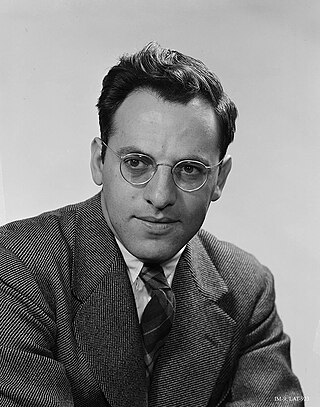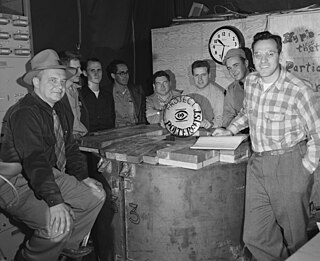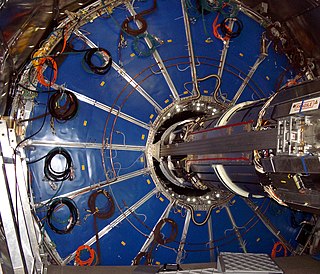Related Research Articles

The Sudbury Neutrino Observatory (SNO) was a neutrino observatory located 2100 m underground in Vale's Creighton Mine in Sudbury, Ontario, Canada. The detector was designed to detect solar neutrinos through their interactions with a large tank of heavy water.

Frederick Reines was an American physicist. He was awarded the 1995 Nobel Prize in Physics for his co-detection of the neutrino with Clyde Cowan in the neutrino experiment. He may be the only scientist in history "so intimately associated with the discovery of an elementary particle and the subsequent thorough investigation of its fundamental properties."

The Cowan–Reines neutrino experiment was conducted by physicists Clyde Cowan and Frederick Reines in 1956. The experiment confirmed the existence of neutrinos. Neutrinos, subatomic particles with no electric charge and very small mass, had been conjectured to be an essential particle in beta decay processes in the 1930s. With neither mass nor charge, such particles appeared to be impossible to detect. The experiment exploited a huge flux of electron antineutrinos emanating from a nearby nuclear reactor and a detector consisting of large tanks of water. Neutrino interactions with the protons of the water were observed, verifying the existence and basic properties of this particle for the first time.

In physics, a time projection chamber (TPC) is a type of particle detector that uses a combination of electric fields and magnetic fields together with a sensitive volume of gas or liquid to perform a three-dimensional reconstruction of a particle trajectory or interaction.

A neutrino detector is a physics apparatus which is designed to study neutrinos. Because neutrinos only weakly interact with other particles of matter, neutrino detectors must be very large to detect a significant number of neutrinos. Neutrino detectors are often built underground, to isolate the detector from cosmic rays and other background radiation. The field of neutrino astronomy is still very much in its infancy – the only confirmed extraterrestrial sources as of 2018 are the Sun and the supernova 1987A in the nearby Large Magellanic Cloud. Another likely source is the blazar TXS 0506+056 about 3.7 billion light years away. Neutrino observatories will "give astronomers fresh eyes with which to study the universe".
IMB, the Irvine-Michigan-Brookhaven detector, was a nucleon decay experiment and neutrino observatory located in a Morton Salt company's Fairport mine on the shore of Lake Erie in the United States 600 meters underground. It was a joint venture of the University of California, Irvine, the University of Michigan, and the Brookhaven National Laboratory. Like several other particle detectors, it was built primarily with the goal of observing proton decay, but it achieved greater fame through neutrino observation, particularly those from Supernova SN 1987A.

MACRO was a particle physics experiment located at the Laboratori Nazionali del Gran Sasso in Abruzzo, Italy. MACRO was proposed by 6 scientific institutions in the United States and 6 Italian institutions.
The Kamioka Observatory, Institute for Cosmic Ray Research is a neutrino and gravitational waves laboratory located underground in the Mozumi mine of the Kamioka Mining and Smelting Co. near the Kamioka section of the city of Hida in Gifu Prefecture, Japan. A set of groundbreaking neutrino experiments have taken place at the observatory over the past two decades. All of the experiments have been very large and have contributed substantially to the advancement of particle physics, in particular to the study of neutrino astronomy and neutrino oscillation.

The Baksan Neutrino Observatory is a scientific laboratory of INR RAS located in the Baksan River gorge in the Caucasus mountains in Russia. Cleared for building in 1967, it started operations in 1977, becoming the first such neutrino observatory in the USSR. It consists of the Baksan Underground Scintillation Telescope (BUST), located 300 m (980 ft) below the surface, the gallium–germanium neutrino telescope located 4,700 m.w.e. deep as well as a number of ground facilities. The Baksan Experiment on Sterile Transitions (BEST) is currently (2019) being conducted at Baksan with aims of understanding sterile neutrinos.

SNOLAB is a Canadian underground science laboratory specializing in neutrino and dark matter physics. Located 2 km below the surface in Vale's Creighton nickel mine near Sudbury, Ontario, SNOLAB is an expansion of the existing facilities constructed for the original Sudbury Neutrino Observatory (SNO) solar neutrino experiment.
Astroparticle physics, also called particle astrophysics, is a branch of particle physics that studies elementary particles of astronomical origin and their relation to astrophysics and cosmology. It is a relatively new field of research emerging at the intersection of particle physics, astronomy, astrophysics, detector physics, relativity, solid state physics, and cosmology. Partly motivated by the discovery of neutrino oscillation, the field has undergone rapid development, both theoretically and experimentally, since the early 2000s.

SNO+ is a physics experiment designed to search for neutrinoless double beta decay, with secondary measurements of proton–electron–proton (pep) solar neutrinos, geoneutrinos from radioactive decays in the Earth, and reactor neutrinos. It is under construction using the underground equipment already installed for the former Sudbury Neutrino Observatory (SNO) experiment at SNOLAB. It could also observe supernovae neutrinos if a supernova occurs in our galaxy.

Nigel Stuart Lockyer is a British-American experimental particle physicist. He is the current director of the Cornell Laboratory for Accelerator-based ScienceS and Education (CLASSE) as of May 1, 2023. He was the Director of the Fermi National Accelerator Laboratory (Fermilab), in Batavia, Illinois, the leading particle physics laboratory in the United States, from September 2013 to April 2022.
The Sanford Underground Research Facility (SURF), or Sanford Lab, is an underground laboratory in Lead, South Dakota. The deepest underground laboratory in the United States, it houses multiple experiments in areas such as dark matter and neutrino physics research, biology, geology and engineering. There are currently 28 active research projects housed within the facility.

The NA62 experiment is a fixed-target particle physics experiment in the North Area of the SPS accelerator at CERN. The experiment was approved in February 2007. Data taking began in 2015, and the experiment is expected to become the first in the world to probe the decays of the charged kaon with probabilities down to 10−12. The experiment's spokesperson is Cristina Lazzeroni. The collaboration involves 333 individuals from 30 institutions and 13 countries around the world.
Centre for Underground Physics in Pyhäsalmi or CUPP is an underground physics laboratory located in Pyhäjärvi, Finland. It occupies part of the CallioLab research and development laboratories, overseen by Callio Pyhäsalmi.
The Deep Underground Neutrino Experiment (DUNE) is a neutrino experiment under construction, with a near detector at Fermilab and a far detector at the Sanford Underground Research Facility that will observe neutrinos produced at Fermilab. An intense beam of trillions of neutrinos from the production facility at Fermilab will be sent over a distance of 1,300 kilometers (810 mi) with the goal of understanding the role of neutrinos in the universe. More than 1,000 collaborators work on the project. The experiment is designed for a 20-year period of data collection.
A geoneutrino is a neutrino or antineutrino emitted in decay of radionuclide naturally occurring in the Earth. Neutrinos, the lightest of the known subatomic particles, lack measurable electromagnetic properties and interact only via the weak nuclear force when ignoring gravity. Matter is virtually transparent to neutrinos and consequently they travel, unimpeded, at near light speed through the Earth from their point of emission. Collectively, geoneutrinos carry integrated information about the abundances of their radioactive sources inside the Earth. A major objective of the emerging field of neutrino geophysics involves extracting geologically useful information from geoneutrino measurements. Analysts from the Borexino collaboration have been able to get to 53 events of neutrinos originating from the interior of the Earth.

The LUX-ZEPLIN (LZ) Experiment is a next-generation dark matter direct detection experiment hoping to observe weakly interacting massive particles (WIMP) scatters on nuclei. It was formed in 2012 by combining the LUX and ZEPLIN groups. It is currently a collaboration of 30 institutes in the US, UK, Portugal and South Korea. The experiment is located at the Sanford Underground Research Facility (SURF) in South Dakota, and is managed by the United States Department of Energy's (DOE) Lawrence Berkeley National Lab.
Herbert Hwa-sen Chen was a theoretical and experimental physicist at the University of California at Irvine known for his contributions in the field of neutrino detection. Chen's work on observations of elastic neutrino-electron scattering provided important experimental support for the electroweak theory of the standard model of particle physics. In 1984 Chen realized that the deuterium of heavy water could be used as a detector that would distinguish the flavors of solar neutrinos. This idea led Chen to develop plans for the Sudbury Neutrino Observatory that would eventually make fundamental measurements demonstrating that neutrinos were particles with mass.
References
- 1 2 3 "Laguna-hanke: Miksi Suomi menetti ison kansainvälisen tutkimuskeskuksen?". Tiedetuubi (in Finnish). Retrieved 2023-10-21.
- ↑ Mainio, Tapio (2012-10-31). "Iso hiukkaskoe ehkä Pyhäjärvelle". Helsingin Sanomat (in Finnish). Retrieved 2023-10-21.
- ↑ HS, Matti Mielonen (2014-08-27). "Selvitys: Pyhäsalmen kaivos paras paikka Cernin hiukkasilmaisimelle". Helsingin Sanomat (in Finnish). Retrieved 2023-10-21.
- ↑ Agostino, Luca; the LAGUNA-LBNO Consortium (2014-12-12). "The LAGUNA/LBNO potential for Long Baseline neutrino physics" (PDF). Journal of Physics: Conference Series. 566: 012002. doi: 10.1088/1742-6596/566/1/012002 . ISSN 1742-6588.
- ↑ "LAGUNA etenee". Tiedetuubi (in Finnish). Retrieved 2023-10-21.
- 1 2 M. Wurm; et al. (2010). "The Physics Potential of the LENA Detector". arXiv: 1004.3474 [physics.ins-det].
- ↑ "LENA". LAGUNA.
- ↑ Laguna sites